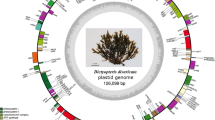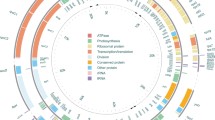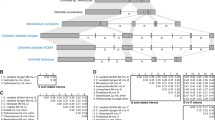Abstract
Chlorarachniophyte algae have complex plastids acquired by the uptake of a green algal endosymbiont, and this event is called secondary endosymbiosis. Interestingly, the plastids possess a relict endosymbiont nucleus, referred to as the nucleomorph, in the intermembrane space, and the nucleomorphs contain an extremely reduced and compacted genome in comparison with green algal nuclear genomes. Therefore, chlorarachniophyte plastids consist of two endosymbiotically derived genomes, i.e., the plastid and nucleomorph genomes. To date, complete nucleomorph genomes have been sequenced in four different species, whereas plastid genomes have been reported in only two species in chlorarachniophytes. To gain further insight into the evolution of endosymbiotic genomes in chlorarachniophytes, we newly sequenced the plastid genomes of three species, Gymnochlora stellata, Lotharella vacuolata, and Partenskyella glossopodia. Our findings reveal that chlorarachniophyte plastid genomes are highly conserved in size, gene content, and gene order among species, but their nucleomorph genomes are divergent in such features. Accordingly, the current architecture of the plastid genomes of chlorarachniophytes evolved in a common ancestor, and changed very little during their subsequent diversification. Furthermore, our phylogenetic analyses using multiple plastid genes suggest that chlorarachniophyte plastids are derived from a green algal lineage that is closely related to Bryopsidales in the Ulvophyceae group.



Similar content being viewed by others
References
Altschul SF, Madden TL, Schäffer AA, Zhang J, Zhang Z, Miller W, Lipman DJ (1997) Gapped BLAST and PSI-BLAST: a new generation of protein database search programs. Nucleic Acids Res 25:3389–3402
Archibald JM (2009) The puzzle of plastid evolution. Curr Biol 19:R81–R88. doi:10.1016/j.cub.2008.11.067
Archibald JM, Lane CE (2009) Going, going, not quite gone: nucleomorphs as a case study in nuclear genome reduction. J Hered 100:582–590. doi:10.1093/jhered/esp055
Besendahl A, Qiu YL, Lee J, Palmer JD, Bhattacharya D (2000) The cyanobacterial origin and vertical transmission of the plastid tRNA(Leu) group-I intron. Curr Genet 37:12–23
Brouard J-S, Otis C, Lemieux C, Turmel M (2011) The chloroplast genome of the green alga Schizomeris leibleinii (Chlorophyceae) provides evidence for bidirectional DNA replication from a single origin in the Chaetophorales. Genome Biol Evol 3:505–515. doi:10.1093/gbe/evr037
Calderon-Saenz E, Schnetter R (1987) Cryptochlora perforans, a new genus and species of algae (Chlorarachniophyta), capable of penetrating dead algal filaments. Plant Syst Evol 158:69–71. doi:10.1007/BF00936146
Calderon-Saenz E, Schnetter R (1989) Morphology, biology, and systematics of Cryptochlora perforans (Chlorarachniophyta), a phagotrophic marine alga. Plant Syst Evol 163:165–176. doi:10.1007/BF00936512
Clark KB, Jensen KR, Stirts HM (1990) Survey for functional kleptoplasty among west Atlantic Ascoglossa (equals Sacoglossa) (Mollusca: Opisthobranchia). Veliger 33:339–345
Curtis BA, Tanifuji G, Burki F et al (2012) Algal genomes reveal evolutionary mosaicism and the fate of nucleomorphs. Nature 492:59–65. doi:10.1038/nature11681
de Vries J, Christa G, Gould SB (2014) Plastid survival in the cytosol of animal cells. Trends Plant Sci 19:347–350. doi:10.1016/j.tplants.2014.03.010
de Vries J, Sousa FL, Bölter B, Soll J, Gould SB (2015) YCF1: a green TIC? Plant Cell 27:1827–1833. doi:10.1105/tpc.114.135541
Gilson PR, Su V, Slamovits CH, Reith ME, Keeling PJ, McFadden GI (2006) Complete nucleotide sequence of the chlorarachniophyte nucleomorph: nature’s smallest nucleus. Proc Natl Acad Sci USA 103:9566–9571. doi:10.1073/pnas.0600707103
Gould SB, Waller RF, McFadden GI (2008) Plastid evolution. Annu Rev Plant Biol 59:491–517. doi:10.1146/annurev.arplant.59.032607.092915
Hilker R, Sickinger C, Pedersen CNS, Stoye J (2012) UniMoG—a unifying framework for genomic distance calculation and sorting based on DCJ. Bioinformatics 28:2509–2511. doi:10.1093/bioinformatics/bts440
Hirakawa Y (2014) Complex plastids of chlorarachniophyte algae. Perspect Phycol 1:87–92. doi:10.1127/pip/2014/0014
Ishida K (2005) Protein targeting into plastids: a key to understanding the symbiogenetic acquisitions of plastids. J Plant Res 118:237–245. doi:10.1007/s10265-005-0218-2
Ishida K, Cao Y, Hasegawa M, Okada N, Hara Y (1997) The origin of chlorarachniophyte plastids, as inferred from phylogenetic comparisons of amino acid sequences of EF-Tu. J Mol Evol 45:682–687. doi:10.1007/PL00006272
Ishida K, Green BR, Cavalier-Smith T (1999) Diversification of a chimaeric algal group, the chlorarachniophytes: phylogeny of nuclear and nucleomorph small-subunit rRNA genes. Mol Biol Evol 16:321–331
Ishida K, Endo H, Koike S (2011) Partenskyella glossopodia (Chlorarachniophyceae) possesses a nucleomorph genome of approximately 1 Mbp. Phycol Res 59:120–122. doi:10.1111/j.1440-1835.2011.00608.x.
Kasai F, Kawachi M, Erata M, Yumoto K, Sato M (2009) NIES-collection list of strains, 8th edition. Jpn J Phycol (Sorui) 57:220
Katoh K, Toh H (2008) Recent developments in the MAFFT multiple sequence alignment program. Brief Bioinform 9:286–298. doi:10.1093/bib/bbn013
Keeling PJ (2010) The endosymbiotic origin, diversification and fate of plastids. Philos Trans R Soc B Biol Sci 365:729–748. doi:10.1098/rstb.2009.0103
Kikuchi S, Bedard J, Hirano M et al (2013) Uncovering the protein translocon at the chloroplast inner envelope membrane. Science 339:571–574. doi:10.1126/science.1229262
Kim JI, Yoon HS, Yi G, Kim HS, Yih W, Shin W (2015) The plastid genome of the cryptomonad Teleaulax amphioxeia. PLoS One 10:e0129284. doi:10.1371/journal.pone.0129284
Kuhsel MG, Strickland R, Palmer JD (1990) An ancient group I intron shared by eubacteria and chloroplasts. Science 250:1570–1573
Lagesen K, Hallin P, Rødland EA, Staerfeldt H-H, Rognes T, Ussery DW (2007) RNAmmer: consistent and rapid annotation of ribosomal RNA genes. Nucleic Acids Res 35:3100–3108. doi:10.1093/nar/gkm160
Lambowitz AM, Zimmerly S (2004) Mobile group II introns. Annu Rev Genet 38:1–35. doi:10.1146/annurev.genet.38.072902.091600
Lang BF, Laforest M-J, Burger G (2007) Mitochondrial introns: a critical view. Trends Genet 23:119–125. doi:10.1016/j.tig.2007.01.006
Leliaert F, Lopez-Bautista JM (2015) The chloroplast genomes of Bryopsis plumosa and Tydemania expeditiones (Bryopsidales, Chlorophyta): compact genomes and genes of bacterial origin. BMC Genom 16:204. doi:10.1186/s12864-015-1418-3
Lemieux C, Otis C, Turmel M (2014) Six newly sequenced chloroplast genomes from prasinophyte green algae provide insights into the relationships among prasinophyte lineages and the diversity of streamlined genome architecture in picoplanktonic species. BMC Genom 15:857. doi:10.1186/1471-2164-15-857
Lü F, Xü W, Tian C, Wang G, Niu J, Pan G, Hu S (2011) The Bryopsis hypnoides plastid genome: multimeric forms and complete nucleotide sequence. PLoS One 6:e14663. doi:10.1371/journal.pone.0014663
Nguyen L-T, Schmidt HA, von Haeseler A, Minh BQ (2015) IQ-TREE: a fast and effective stochastic algorithm for estimating maximum-likelihood phylogenies. Mol Biol Evol 32:268–274. doi:10.1093/molbev/msu300
Price DC, Chan CX, Yoon HS et al (2012) Cyanophora paradoxa genome elucidates origin of photosynthesis in algae and plants. Science 335:843–847. doi:10.1126/science.1213561
Rodríguez-Ezpeleta N, Brinkmann H, Burey SC, Roure B, Burger G, Löffelhardt W, Bohnert HJ, Phillipe H, Lang BF (2005) Monophyly of primary photosynthetic eukaryotes: green plants, red algae, and glaucophytes. Curr Biol 15:1325–1330. doi:10.1016/j.cub.2005.06.040
Rogers MB, Gilson PR, Su V, McFadden GI, Keeling PJ (2007) The complete chloroplast genome of the chlorarachniophyte Bigelowiella natans: evidence for independent origins of chlorarachniophyte and euglenid secondary endosymbionts. Mol Biol Evol 24:54–62. doi:10.1093/molbev/msl129
Ronquist F, Teslenko M, Van Der Mark P, Ayres DL, Darling A, Höhna S, Larget B, Liu L, Suchard MA, Huelsenbeck JP (2012) Mrbayes 3.2: efficient bayesian phylogenetic inference and model choice across a large model space. Syst Biol 61:539–542. doi:10.1093/sysbio/sys029
Rutherford K, Parkhill J, Crook J, Horsnell T, Rice P, Rajandream MA, Barrell B (2000) Artemis: sequence visualization and annotation. Bioinformatics 16:944–945
Schattner P, Brooks AN, Lowe TM (2005) The tRNAscan-SE, snoscan and snoGPS web servers for the detection of tRNAs and snoRNAs. Nucleic Acids Res 33:W686–W689. doi:10.1093/nar/gki366
Suzuki S, Shirato S, Hirakawa Y, Ishida K (2015) Nucleomorph genome sequences of two chlorarachniophytes, Amorphochlora amoebiformis and Lotharella vacuolata. Genome Biol Evol 7:1533–1545. doi:10.1093/gbe/evv096
Takahashi F, Okabe Y, Nakada T, Sekimoto H, Ito M, Kataoka H, Nozaki H (2007) Origins of the secondary plastids of Euglenophyta and Chlorarachniophyta as revealed by an analysis of the plastid-targeting, nuclear-encoded gene psbO. J Phycol 43:1302–1309. doi:10.1111/j.1529-8817.2007.00411.x
Tamura K, Stecher G, Peterson D, Filipski A, Kumar S (2013) MEGA6: molecular evolutionary genetics analysis version 6.0. Mol Biol Evol 30:2725–2729. doi:10.1093/molbev/mst197
Tanifuji G, Onodera NT, Brown MW, Curtis BA, Roger AJ, Ka-Shu Wong G, Melkonian M, Archibald JM (2014) Nucleomorph and plastid genome sequences of the chlorarachniophyte Lotharella oceanica: convergent reductive evolution and frequent recombination in nucleomorph-bearing algae. BMC Genom 15:374. doi:10.1186/1471-2164-15-374
Timmis JN, Ayliffe MA, Huang CY, Martin W (2004) Endosymbiotic gene transfer: organelle genomes forge eukaryotic chromosomes. Nat Rev Genet 5:123–135. doi:10.1038/nrg1271
Turmel M, Otis C, Lemieux C (2009) The chloroplast genomes of the green algae Pedinomonas minor, Parachlorella kessleri, and Oocystis solitaria reveal a shared ancestry between the Pedinomonadales and Chlorellales. Mol Biol Evol 26:2317–2331. doi:10.1093/molbev/msp138
Turmel M, Otis C, Lemieux C (2015) Dynamic evolution of the chloroplast genome in the green algal classes Pedinophyceae and Trebouxiophyceae. Genome Biol Evol 7:2062–2082. doi:10.1093/gbe/evv130
Van de Peer Y, Rensing SA, Maier UG, De Wachter R (1996) Substitution rate calibration of small subunit ribosomal RNA identifies chlorarachniophyte endosymbionts as remnants of green algae. Proc Natl Acad Sci USA 93:7732–7736. doi:10.1073/pnas.93.15.7732
Wicke S, Schneeweiss GM, DePamphilis CW, Müller KF, Quandt D (2011) The evolution of the plastid chromosome in land plants: gene content, gene order, gene function. Plant Mol Biol 76:273–297. doi:10.1007/s11103-011-9762-4
Yancopoulos S, Attie O, Friedberg R (2005) Efficient sorting of genomic permutations by translocation, inversion and block interchange. Bioinformatics 21:3340–3346. doi:10.1093/bioinformatics/bti535
Acknowledgments
We thank A. Fujiyama and T. Narita (National Institute of Genetics, Japan) for plastid genome sequencing of L. vacuolata. This work was supported by the Japan Society for the Promotion of Science (JSPS) KAKENHI Grant Numbers: 13206027, 18017011, 23117004, 15K18582, and 14J00572. S. S. is a recipient of the JSPS Research Fellowships for Young Scientists 26-572.
Author information
Authors and Affiliations
Corresponding author
Ethics declarations
Conflict of interest
The authors declare that they have no conflict of interest.
Electronic supplementary material
Below is the link to the electronic supplementary material.
Rights and permissions
About this article
Cite this article
Suzuki, S., Hirakawa, Y., Kofuji, R. et al. Plastid genome sequences of Gymnochlora stellata, Lotharella vacuolata, and Partenskyella glossopodia reveal remarkable structural conservation among chlorarachniophyte species. J Plant Res 129, 581–590 (2016). https://doi.org/10.1007/s10265-016-0804-5
Received:
Accepted:
Published:
Issue Date:
DOI: https://doi.org/10.1007/s10265-016-0804-5




